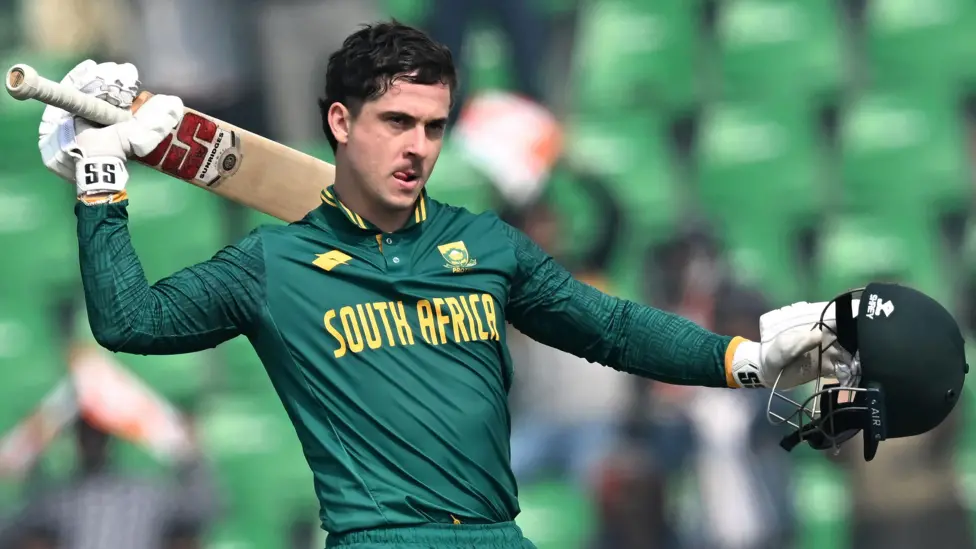2025 has been the year where South Africa has finally been able to erase the tag of ‘Chokers’ from their modern cricketing history after lifting the World Test Championship mace for the 2023-25 cycle. On top of that, they have gone on to clinch 2 successive ODI series away from home versus Australia and England, respectively, which is an indication of a return to form for South African top-order batting, which has been on the decline in recent years.
After the departure of Kallis, Amla, and de Villiers, South African batting hit a slump that was reflected both in their ODI form and their red ball success. The new crop of players, such as Ryan Rickleton, Wiaan Mulder, and Matthew Breetzke, demonstrate how the future of South African batting may be a return to the glory of past world-beating teams that South Africa has had.
The top order
South Africa has recently stuck with the opening pair of Markram and Rickleton. Both of them are T20 regulars in franchise leagues outside the world and are quite aggressive openers for both white-ball and red-ball cricket. Markram won the WTC final for South Africa with his century while chasing 282 in the 4th innings. Markram now averages 45.64 in the 4th innings and brought up his 3rd century in the 4th innings in the WTC final.
Markram’s match factor for tests between 2024 and 2025 is 1.69, which means he has been 69% better than batters in his matches. Ryan Rickleton has accumulated a match factor of 1.78 during the same period. Ryan Rickelton’s 259 against Pakistan put him on the map and steadied his spot in the South African top order. He still has to work on his consistency to ensure that his aggression brings the most returns for South African batting.
Wiaan Mulder is South Africa’s most recent experiment in the no. 3 role when it comes to test cricket, and he has taken to the role like a duck to water with his 367* against Zimbabwe earlier this year. In ODIs he has managed to contribute with some lower-order hitting and claim valuable wickets in the middle overs with his bowling. While Tony De Zorzi hasn’t managed to announce himself as well as the other contenders, he is still a promising player with technical flair who only needs a run of scores to cement his place in the team.
Middle order

The last WTC cycle was the peak of Temba Bavuma’s batting, capped off by him leading from the front when he got South Africa their first major title in decades. His average was a whopping 59.25 during the last WTC cycle, and he is among the best No. 4s in test cricket currently. David Bedingham, who has been a red-ball specialist with an impressive First Class record, also provided valuable runs for them in the WTC final.
Tristan Stubbs has been inducted into their red ball team on the back of his white ball exploits. He is seen as an all-format player who came into the spotlight with his exploits for Delhi Capitals in the IPL. At No. 5, he is a new-age batter who loves playing freely in Test cricket in the vein of Rishabh Pant, Travis Head, or Harry Brook.
Matthew Breezke has started in ODIs with almost Bradman-esque form, with five 50+ scores in his first five innings of ODI cricket. If given the chance, he’d prove to be an asset to increase South African batting depth in test cricket as well.
The recent entrants into the South African side, namely Dewald Brevis and Lhuan Dre Pretorious, have taken the world by storm with their aggressive hitting in the IPL and SA20, respectively. With both of them getting handed test debuts against Zimbabwe recently, it is evident that CSA is looking at them as all-format players. Brevis and Pretorious have strike rates of 155.28 and 144.06, respectively, in T20s.
What is the way forward for South African batting?
South Africa’s batting core at the present moment is made up of multi-format players. With the exception of Bedingham and Verreyne, the other top-order and middle-order batters are not red-ball specialists. The recent inclusion of Brevis and Pretorious into red-ball setups is an indication that South Africa wants to build a batting core that can give them multi-format success.
The last era has been dominated by the wobble ball bowling, and batters have struggled to make runs on seam-friendly pitches of the WTC era. South Africa has an efficient bowling lineup that is quite capable of taking 20 wickets frequently. Hence, choosing batters who have had success in the white-ball format allows them to play with more freedom and get enough runs on the board, which their bowlers can then defend.
With one eye towards the 2027 ODI World Cup and looking to continue their domination into the next WTC cycle, Temba Bavuma and his men plan to rebuild their team centered around aggression, intent and a positive playing mindset when it comes to their batting.


[…] Delhi Capitals are eager to come with both fresh and seasoned players. […]